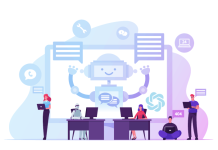
Omnichannel is everywhere—vendor marketing, analyst articles, conference sessions, client wish lists. While touted as a new concept, it doesn’t seem all that different from the multimedia routing and reporting (MMRR) that have been around for years and have been so difficult to achieve.
Most ACD agent interfaces allow for managing contacts in all media by adjusting work states and providing real-time data on the various contacts in queue. They’re adding customer interaction channels (e.g., text/SMS) and seeking to extend skills, conditional routing and other core tools to all media. CRM serves as the agent’s transaction interface and the source of much of the customer profile and contact history. CRM can route and report on channels other than voice (typically email, chat and social media, moving toward text/SMS), and some vendors support voice through built-in capabilities, acquisitions, or partnerships.
The challenge in these traditional scenarios is that CRM functionality overlaps the traditional multimedia ACD and can drive confusion about what to do where, often resulting in point solutions that don’t get integrated. Moreover, because channels are still owned in siloed departments, the path of least resistance tends toward use of different solutions rather than a coordinated, coherent technology and operations plan. Beyond cumbersome administration and routing, reporting suffers when contacts are routed by different applications.
The emerging Customer Engagement Hub (CEH) endeavors to pull it all of the functionality together for omnichannel success. Some CRM vendors, such as Pega, are specifically evolving their solution to perform these functions. ACD vendors, such as Avaya (Oceana) and Genesys (Customer Experience Platform) are expanding their interface and functions to fill the need. However, there is a new breed of vendors that offer hub functionality while leveraging existing technology investments and minimizing operational disruption.
CEH solutions provide “easy” integration across websites, mobile apps, email servers, social media, advertising and campaign management, ERP, CRM, contact center technology and knowledge aids (externally and internally focused). They support functions such as real time monitoring and context of customer journeys, single desktop interface across much of the company, process building and automation, data and application connectivity and integration, and dashboards and analytics. They drive more customer centric and dynamic proactive outbound communication, flexible self-service, concierge assisted service, and detailed analytics of the customer experiences for conclusions. They integrate data collected at all customer touch points, including self-service, assisted service, store visits, and websites. CEHs provide the contact center agent interface for consistent delivery of contacts across all media within the same window with full context of the customer history and current experience as well as integration for knowledge aids. Reporting can still be the challenge as in many of the other options.
Contact center vendors have been forced to respond to the CEH threat. A few vendors offer a multimedia ACD with customer experience platform or customer engagement hub included. This solution delivers an omnichannel desktop workspace for the agent with a consistent user interface across all channels. The solution enables integration to other data sources for customer history, account details, knowledge aids, etc. and embeds CRM for additional data and transacting. The ACD with CEH is attempting to resolve the routing functionality confusion by keeping routing in the ACD. Enhanced functionality such as dynamic tool bars that change depending on channel, email and chat management functionality (e.g., spell check, templates, etc.), and full visibility into the current interaction journey across all channels is added.
Cloud ACD solutions that have traditionally focused on voice are also getting into the omnichannel game. Their value is based on the solution being simple to use, implement, and support. These solutions rely on others to deliver the full omnichannel experience. These vendors typically partner with the biggest CRM solution providers, such as Salesforce.com, Microsoft Dynamics, ZenDesk. From what we’ve seen so far, reporting and other functions aren’t comparable to what we’re used to in the voice world, but they have a different focus—fast, easy, low cost. The data is there, but analysts will have to create integrated reporting that delivers what contact center managers need for efficient operations and decision making across channels, and likely across platforms.
The market is filled with acquisitions and partnerships to resolve the confusion inherent in achieving the omnichannel goal. Whether these tools can gain traction remains to be seen.




